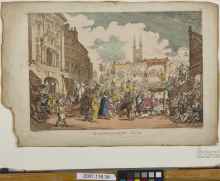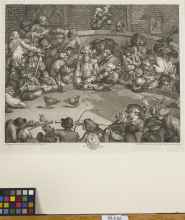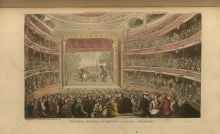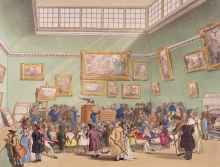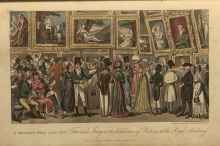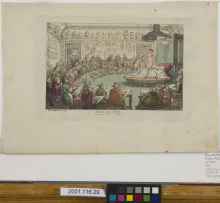The Chamber Idyll
This intimate domestic scene portrays two lovers who, because of their profound absorption in each other, are simultaneously spectator and spectacle.
Bartholomew Fair
St. Bartholomew’s Fair was one of the highlights of the London social season, drawing crowds from all strati of society.
The Cockpit
This image depicts a cockfight, with special emphasis on the diversity of spectators in attendance and their singularity of purpose (gambling).
Doctor Syntax at Covent Garden Theatre
In this illustration of William Combe's comic text, Dr. Syntax seeks the picturesque in the theater.
9th. 10th. & 11th. Windows North Aisle
This illustration, created by John White to accompany William Combe's written history of Westminster, gives an interior view of the Abbey and depicts several of its monuments. The bottom border of the image includes the names of the persons to whom the monuments are dedicated, along with corresponding numbers for identification.
Christie's Auction House
This image depicts an art exhibition and sale at Christie's, London's famous auction house, drawing attention not only to the displayed artwork but also to the busy social scene.
A SHILLING WELL LAID OUT. Tom and Jerry at the Exhibition of Pictures at the Royal Academy
This image depicts Tom and Jerry—the two main characters from Pierce Egan's popular journal, Life in London—attending the Annual Exhibition of the Royal Academy.
Royal Academy - Somerset House, London
In this image, students of the Royal Academy at Somerset House are trained in the techniques of observing and depicting the female nude.
You're Blocking My View!: The Spectator in the Romantic Art World
Romantic London is a city of spectacles: from Bartholomew Fair to Covent Garden, from the Great Exhibition Hall to the Royal Academy. These spectacles serve as both the location and occasion for a wide range of viewing practices and interactions, as spectators turn their gaze from the stage and exhibit to the boxes and crowds. This gallery seeks to examine the notions of the viewer and the gaze through the crowd scenes afforded by London’s social calendar of cultural spectacles. Focusing on the formation of the art spectator, this gallery traces the various modes of viewing art—from its conception in life-drawing classes to its display at the Royal Academy Exhibition, and finally to its place in the private collection.


